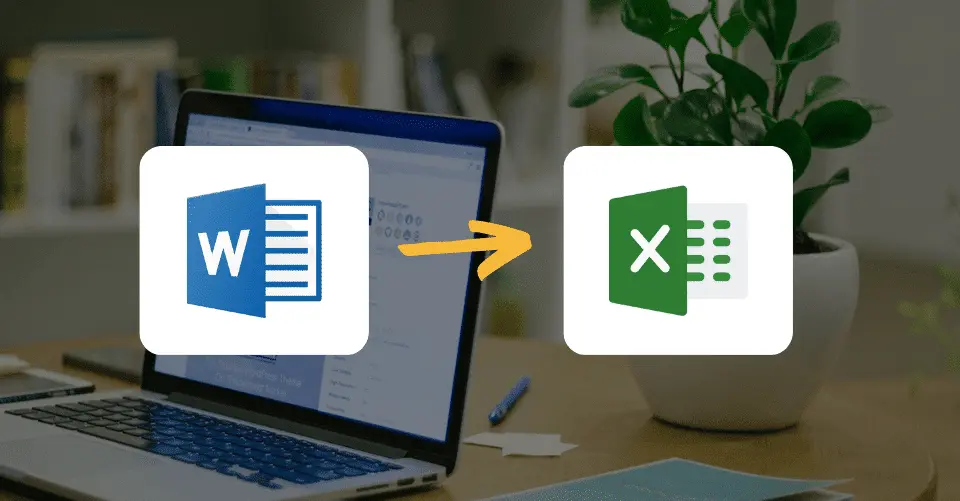The Microsoft Office 365 suite is used by over a million companies worldwide, and for good reasons. All Office programs are interoperable and user-friendly for casual users and industry professionals alike.
Converting a Word file to an Excel worksheet is relatively easy, and so is converting a Microsoft Word or Excel file into a PDF file. You can also convert Word files to a plain text format that works on any other platform. Use this guide to convert any Word document to Microsoft Excel.
How to Convert a Word Document to an Excel Spreadsheet
You may need to convert Word document data to Microsoft Excel for many reasons. A business receives lots of data in Word format for research, market analysis, company evaluations, and forecasting to make the right investment decisions.
The Microsoft Word document containing this information converts to an Excel sheet to conduct thorough data analysis. You can then run formulas, create charts and graphics, and assimilate the Excel data into other software applications in the business.
Follow these steps to convert Word document data to an Excel worksheet.
Using Paste Special
- Select the Word data and copy.
- Either:
- Navigate to the Home tab on Excel, select Paste, then Paste Special, or
- Right-click on your worksheet and choose Paste Special from the pop-up menu.
- Select your pasting options from the Paste Special menu. You can opt to keep source formatting, add basic operations (add, subtract, divide, multiply), transpose the data, and several other options.
- Click OK to paste the data into your Excel worksheet.
Using Save As
- Open your Word document that you want to convert to Excel.
- Click File, and then Save As.
- Under Save as type, choose Plain Text from the drop-down list.
- On the File Conversion dialog box, check the Preview box to see the formatting in your document. Click OK to save the TXT file.
- Open Excel and click on the Data tab.
- Select From the text, then choose the TXT file and click Import.
- On the Text Import wizard, follow the steps to select the delimiters on your data, how to structure the data, and the data format. Use the data preview box to see how each option affects the output data.
- Once the data meets your requirements, click Finish.
- On the Import Data dialog box, choose where you want to put your data, either on a new or existing worksheet. Click OK.
- Check that your word data is converted into the spreadsheet as desired.
Note:
These steps also work for Google Docs. Save your Google document as a TXT file and import it into Microsoft Excel. Your converted Excel spreadsheet can open with Google Sheets too.
How to Manually Convert MS Word Documents to Excel
If you have documents in other formats, such as Rich Text Format (RTF), PDF, or even hard copies, you can still convert them to Excel format.
RTF to Excel
- Open your RTF file in WordPad and remove all graphics from the document.
- Format the data only using tabs and enter (return) to separate pieces of information. Tabs will serve as column breaks, while enter keys will mark the rows on your spreadsheet.
- Ensure that each row of data has an equal number of tabs. This enables the data to display correctly on Excel.
- Use the Save As an option to save the document as a TXT file.
- Import the data using the Save As process outlined above.
PDF to Excel
- Use a PDF converter to convert your PDF document to word form data.
- Check the Word document to verify the converted data.
- Use the Paste Special or Save As methods to open your document with Excel.
Hard Copy to Excel
- Scan your hard copy documents and save them as PDF files.
- Use an optical character recognition (OCR) app to extract the text on the scanned PDF files.
- Depending on the data type, export the OCR data in TXT, RTF, DOC, or DOCX format, depending on the data type.
- Follow the Save As a method to import the data to Excel.
As you can see, there is no limit to the type of documents you can convert into Excel format. As long as you can read the data in Microsoft Word, Google Docs, or PDF, convert it to plain text first.
How Parserr Can Automatically Convert Bulk Word Docs to Excel
While the above methods work great for converting Word and other formats to Excel, they’re better suited for one document at a time.
However, if you’re dealing with multiple Word files from various sources or documents that are hundreds of pages long, you need an automated data extraction solution. Parserr can automatically convert bulk Word files to Excel. Simply add DOC and DOCX files as a parsing source, and Parserr will do the rest.
First, ensure that your Word documents upload on cloud storage, such as Dropbox, Box, or Google Drive. Do the same with every PDF file you want to extract with Parserr. Next, set your parsing rules to capture the relevant data from your documents.
Parserr can extract data from plain text, links, PDF table data, and more. Once you’re happy with the parsing rules, you can export your parsed data straight into an Excel format or right into your CRM system.
With Parserr, you can skip the manual Excel conversion process and let the algorithm work instead. Your data extraction process runs 24/7 in the background, handling every Word document as it arrives.
Apply Parserr to every type of file format, including XML data, and receive highly accurate information to build upon your business. This ultimately translates into resource savings, greater productivity, and streamlined processes.
You need no coding skills to use Parserr, and you certainly don’t need to spend precious time converting your Word documents one at a time. Automate the entire data extraction process and dedicate your resources to gather insights from your data and make the best-informed decisions. Learn more about how Parserr can convert data from all sources today. Contact us now.











